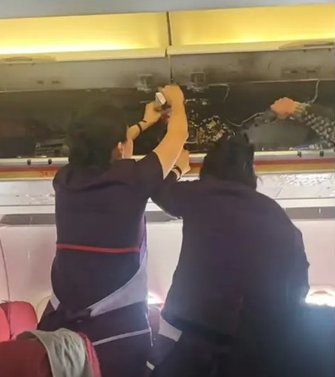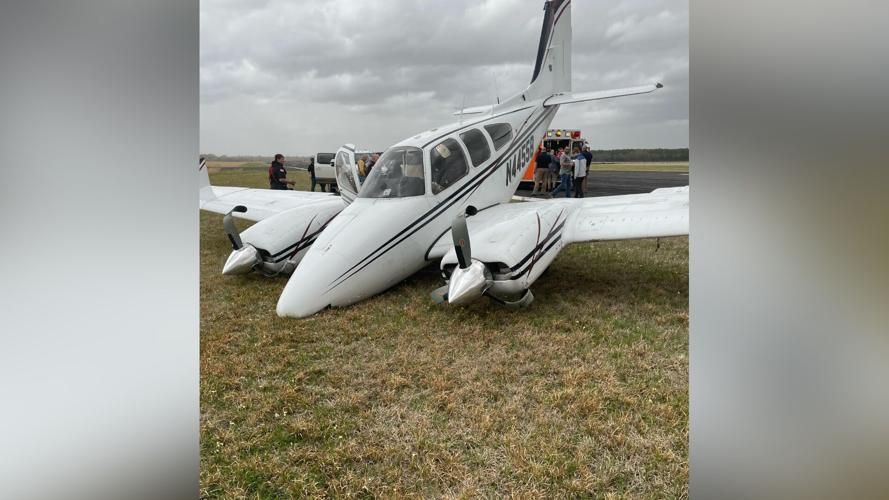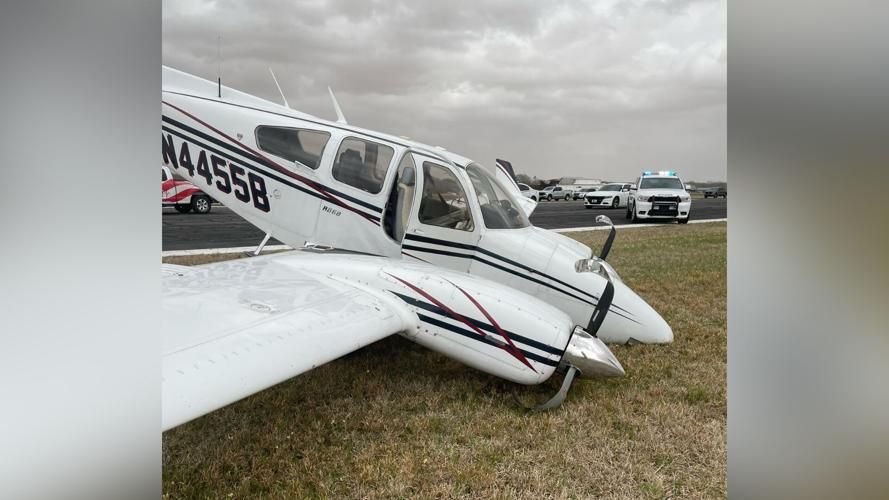ARFF Daily News
Published on:
Thursday the 20th of March, 2025
Hong Kong Airlines flight from Hangzhou makes emergency landing in Fuzhou after cabin fire
By FL360aero
A Hong Kong Airlines flight from Hangzhou (HGH) to Hong Kong (HKG) was diverted due to a fire in the overhead luggage compartment, but landed safely at Fuzhou Changle International Airport (FOC) on Thursday (March 20, 2025).
The Hong Kong Airlines flight HX115, operated by an Airbus A320-232 aircraft (B-LPC), was just 15 minutes enroute to Hong Kong at the time of incident. Hong Kong Airlines said that the fire had been successfully extinguished and it was now fully committed to providing assistance to passengers and crew members.
As per the footage available, crew and passengers using water and juice to put out the flames. One passenger described the scene as “like a movie”.
The flight HX115 took off from Hangzhou Xiaoshan Airport at 12:56 p.m. on Thursday and was originally scheduled to land in Hong Kong at 2:56 p.m., but due to the "cabin fire" it made an emergency landing at Fuzhou Changle Airport at 1:56 p.m. It is not yet known how many people were on board.
After the plane landed safely on Runway 03 in Fuzhou, the aircraft taxiied to the designated gate, the passengers disembarked and took a shuttle bus to reach the terminal. Emergency responders and Fire trucks were on standby at the apron, but were not used as the situation was under control.
As per latest reports, the incident did not cause any casualties, and it was suspected that the fire was caused by a mobile charging device (power bank).
From the footage of the incident, some passengers left their seats and squatted in the aisle before the plane landed.
As per the reports, the fire broke out inflight and inside the overhead luggage rack which alerted the passengers and crew. After the cabin attendants and passengers put out the fire, they continued to pour water and drinks to prevent it from re-igniting. The luggage rack was burnt and severely blackened.
Its to be noted that various airlines have started banning the usage of power banks inflight due to the risk of battery fire hazard which could endanger the flight safety.
Recently, Singapore Airlines and its subsidiary Scoot changed thier Power bank carriage policy for safe operation of flight. Effective 1st April 2025, Singapore Airlines customers will not be allowed to use portable power banks during a flight.
In January this year, Air Busan caught fire on a flight from Busan to Hong Kong, and it was later discovered that it was suspected that a mobile power bank or related electronic equipment was causing the accident.
In addition to many Korean airlines, the regulations have been changed to require passengers not to use mobile power banks during flights.
Taiwan's EVA Air also announced last month that it will prohibit the use of mobile power banks (also known as power banks or chargers) and spare lithium batteries on aircraft from March 1, and these two items are also prohibited from being checked in.
EVA Air announced the new rule through its Facebook page and advised passengers to fully charge their devices before boarding, or use the AC socket and USB (Type A) charging port on board to charge electronic products.
According to EVA Air's official website, all of its fleets are equipped with seat AC sockets in the Royal Seal Laurel Cabin, Laurel Cabin and Premium Economy Class. This service is also available in Economy Class for passengers travelling on 787, 777-300ER or A330-300 aircraft (with the exception of some Economy Class seats on the 777-300ER).
EVA Air stresses that power banks and spare lithium batteries are also strictly prohibited from being checked in, and passengers must carry them with them and store them properly to avoid crushing or damage to ensure flight safety.
https://fl360aero.com/detail/hong-kong-airlines-flight-from-hangzhou-makes-emergency-landing-in-fuzhou-after-cabin-fire/2055

No major injuries in small plane crash in Grenada
By: Zac Carlisle
GRENADA, Miss. (WTVA) — A small plane crashed at the airport in Grenada.
This happened Wednesday afternoon, March 19.
Grenada County Emergency Management Director Chris Whitehurst reported no major injuries.
He said 911 received the emergency call at 2:38 p.m.
He said it appears the plane tried to land and crashed on its nose.
Four people were on board but only two are being medically evaluated, he said.
Whitehurst later clarified one of the passengers was an Angel Flight patient who was being transported for medical services.
https://www.wtva.com/news/local/no-major-injuries-in-small-plane-crash-in-grenada/article_53316ead-faa1-4372-880f-56a89ec9cabe.html


Small plane skids into ditch at Henderson airport, no injuries reported
by News 3 Staff
Las Vegas (KSNV) — A Malibu 171 aircraft skidded into a ditch adjacent to the runway at Henderson Executive Airport upon landing around 10:18 a.m. on Wednesday morning.
A spokesperson at Henderson Executive Airport confirmed there were three occupants on the aircraft and all safely exited without injury.
There was a small fuel leak.
Fire department and airport personnel responded to the scene.
A spokesperson from the FAA released a statement on the plane crash,

FAA: Helicopter crashes in Columbia County
By Dan Thesman
DAYTON, Washington – The Federal Aviation Administration reports a Bell 206B helicopter crashed near Dayton around 12:30 p.m. Wednesday.
“Only the pilot was on board,” FAA Public Affairs Specialist Steven Kulm said.
Kulm added that the FAA and National Transportation Safety Board will conduct an investigation.
Columbia County Sheriff’s Office Civil Deputy Sarah Boudrieau said the scene is near South Touchet Road outside of Dayton. She explained the helicopter crash caused a power outage in the area.
Due to no electricity, an emergency order was issued closing the Columbia County offices at the courthouse earlier in the day. The courthouse will reopen tomorrow (Thursday) at 8:30 a.m. Power at the courthouse has since been restored.
This is a developing story. We will update it as more information is released.
https://elkhornmediagroup.com/faa-helicopter-crashes-in-columbia-county/

NTSB Final Report: Dennis T Kirby/Michael B Kirby Murphy Rebel
(Pilot) Reported That During The Takeoff Roll, The Flight Controls “Felt Funny”
Location: Edgewood, New Mexico Accident Number: WPR24LA175
Date & Time: June 4, 2024, 08:53 Local Registration: N79ZT
Aircraft: Dennis T Kirby/Michael B Kirby Murphy Rebel Aircraft Damage: Substantial
Defining Event: Sys/Comp malf/fail (non-power) Injuries: 1 Minor
Flight Conducted Under: Part 91: General aviation - Personal
Analysis: The pilot reported that he had a “controllability issue” during takeoff and lost directional control. According to an FAA inspector, the airplane then veered right, exited the runway, and impacted a berm. Subsequently, the airplane had a post-crash fire and was destroyed.
The pilot informed the FAA inspector that he improperly reconnected the ailerons and flaps prior to the accident flight. The pilot further reported that during the takeoff roll, the flight controls “felt funny” and realized that he had mis-rigged the aileron and flap controls. The pilot did not submit the National Transportation Safety Board Pilot/Operator Aircraft Accident/Incident Report Form 6120.1 as requested.
Probable Cause and Findings: The National Transportation Safety Board determines the probable cause(s) of this accident to be -- The pilot’s improper installation of the aileron and flap control systems, which resulted in a loss of directional control during the takeoff roll and subsequent runway excursion.
FMI: www.ntsb.gov

Today in History
56 Years ago today: On 20 March 1969 A United Arab Airlines Ilyushin Il-18 crashed during landing at Aswan Airport, Egypt, killing 100 occupants; 5 survived the accident.
Date: Thursday 20 March 1969
Time: 02:00
Type: Ilyushin Il-18D
Owner/operator: United Arab Airlines - UAA
Registration: SU-APC
MSN: 188011301
Year of manufacture: 1969
Total airframe hrs: 128 hours
Fatalities: Fatalities: 100 / Occupants: 105
Other fatalities: 0
Aircraft damage: Destroyed, written off
Category: Accident
Location: Aswan Airport (ASW) - Egypt
Phase: Landing
Nature: Passenger - Non-Scheduled/charter/Air Taxi
Departure airport: Jeddah International Airport (JED/OEJD)
Destination airport: Aswan Airport (ASW/HESN)
Narrative:
A United Arab Airlines Ilyushin Il-18 crashed during landing at Aswan Airport, Egypt, killing 100 occupants; 5 survived the accident.
Rising sand in the Aswan area caused the visibility to drop from 10 km to 2-3 km. The flight had made 2 missed NDB approaches to Aswan Airport and was approaching for the third time when it suddenly banked right. The right wing contacted the left side of the runway 1120 m from the threshold. The wing broke off and the aircraft crashed in flames.
PROBABLE CAUSE: "Pilot descended below the minimum safe altitude without having the runway lights clearly in sight. A contributory factor was fatigue arising from continuous working hours without suitable rest periods."

